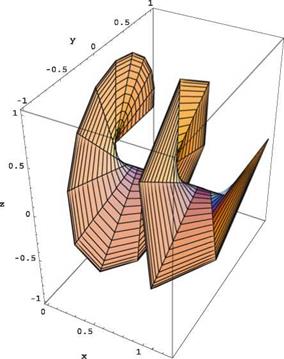Vortex Model and Strip Theory—The Goldstein Model
10.3.1 General Comments
The next level of modelization is the extension of the Prandtl lifting line theory, developed by Prandtl [6] for studying the inviscid flow past finite wings, to the flow past a rotor. The fundamental difference is in the shape of the vortex sheet. Behind a wing, the vortex sheet, often called “wake” even though the model is inviscid, can be assumed to be a surface generated by semi-infinite lines or vortices, originating at the
 |
sharp trailing edge of the wing and parallel to the incoming velocity vector. These vortices, according to the Biot-Savart formula, induce at the wing, represented as a single line (the lifting line), a velocity component w, perpendicular to the incoming flow, called “downwash”. In contrast, behind a rotor, the vortex sheets are modeled as perfect helices, obtained by rotating and translating a segment of straight line perpendicular and in the same plane as the axis. Each blade is represented by such a segment and generates an individual vortex sheet. The rotation corresponds to the rotor speed of rotation Q. The translation velocity varies from U + u at the rotor plane, to U + 2u far downstream, as shown in the one-dimensional flow theory. These helicoidal surfaces are made of helicoidal vortices that induce, according to the Biot-Savart formula, velocity components that affect the local incidences of the blade elements through the axial and azimuthal contributions. This is the Goldstein model [7]. See Fig. 10.8.
The simplifications associated with this model are important to understand. The fundamental choice is to prescribe the shape of the vortex sheets as perfect helices. This is often described as prescribed wake model or rigid wake model. The same is true of the wake model in the Prandtl lifting line theory, which is aligned with the undisturbed flow, yet yields very reasonable results. From a physical point of view, vortex sheets are surfaces of discontinuity of the velocity vector, wetted on both sides by the fluid and find an equilibrium position such that the pressure is continuous
across them. From a practical point of view, if the prescribed vortex sheets are close to the actual ones, the evaluation of the induced velocities will be accurate to first – order, as is the case of Prandtl’s theory and in the transfer of the tangency condition from the actual profile to the nearby axis in small disturbance theory of thin airfoils. In this method, the prescribed vortex structure satisfies an “equilibrium condition” by matching the absorbed rotor power with the power deficit in the far field, as will be seen later.
Another simplification consists in neglecting the rolling-up of the sheets edges, a well-known phenomena in aircraft aerodynamics associated with tip vortices that can create a hazard for small aircrafts flying in the tip vortices wake of large transport airplanes. Results indicate that keeping the sheets flat does not affect the accuracy of the simulation since the rolling-up does not change the vorticity content of the wake, only displaces it slightly.
The average axial velocity decreases behind the rotor. As a consequence, the stream tube diameter increases. The helicoidal vortex sheets would be expected to expand, however, this is not accounted for and possibly does not need to, since the rolling up of the sheets edges may partially counter this effect. It is believed that the rolling-up of the vortex sheets as well as the stream tube expansion are second-order effects, hence neglecting to account for them does not jeopardize the results.
The centrifugal and Coriolis forces are also neglected, which is acceptable for large wind turbines.
Free wake models have been developed in which the vortex sheets are allowed to find their equilibrium position as part of a Lagrangian iterative process in which vorticity is shed by the blades and convected downstream. Experience has shown that these methods are unstable. The vortex filaments tend to become disorganized and chaotic downstream of the rotor. Artificial dissipation is needed to prevent the calculation from diverging, which defeats the purpose of keeping the wake dissipation free, as expected with an inviscid model. Another aspect is that the number of vorticity laden particles increases with each time step and the run time per iteration increases quickly to excessive values as N3, where N is the number of particles. In the end, the free wake models are neither reliable nor efficient.











